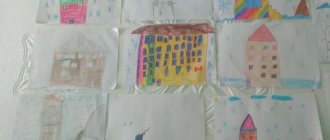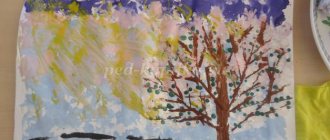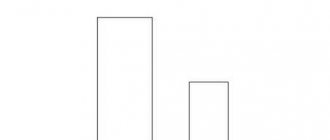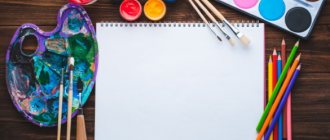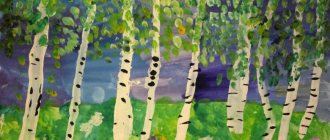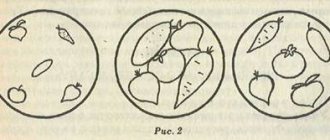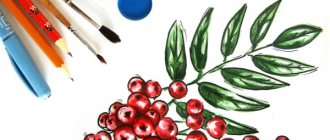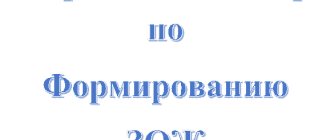Summary of an open drawing lesson in the middle group “Teddy Bear”
MKDOU Selivanikha kindergarten
Summary of
an open drawing lesson in the middle group. Topic: “Teddy Bear”
Compiled by teacher: Tonkikh L.P.
2014 Lesson: Drawing.
Topic: "Teddy Bear". Goal:
1. Continue learning to master drawing examples (round and oval shapes), paint them in a circular motion, carefully, without going beyond the contour.
2. Be able to convey the characteristic features of an animal (bear), observing proportions. 3. Fix the shape, color, size. 4. Foster independence and accuracy in work. 5. Develop invention, creativity, fantasy. Materials:
Landscape paper (according to the number of children), paints, brushes, cups of water;
toy bear"; example of a teacher; group design: “Winter Glade”: Christmas trees, “drifts”; text of a story about a bear with musical accompaniment. Previous work:
Reading fairy tales, stories, memorizing poems, guessing riddles, looking at illustrations, learning games, etc.
Artistic word:
Making a riddle about a bear, a story about a bear.
Individual work:
With Vika, Valeria - teach children to convey the characteristic features of an animal.
Methodical techniques:
1. Conversation about animals (domestic and wild);
name them; why are they called that? 2. The teacher asks a riddle; 3. Guessing the answer by children; 4. Game technique; 5. Consolidation of shapes, colors, sizes; 6. The teacher demonstrates the technique of drawing and painting a bear figure with an explanation; 7. Independent work of children, accompanied by the story “About the Bear” with a teacher, using a musical soundtrack; 8. Analysis of children's works; 9. Dynamic pause (to music). Progress of the lesson.
Children enter the group room, paying attention to the guests.
Children greet guests and sit on chairs. I’m having a conversation about animals:
Q. – What animals do children know?
Name it. D. – Children’s answers. V. – What animals are these? D. – Children’s answers. V. – Why are they called that? D. – Children’s answers. V. – What animals do children still know? Please call me. D. – Children’s answers. V. – What kind of animals are these? Why are they called that? D. – Children’s answers. V. - Well done! Right! Gaming technique. I draw the children’s attention to the fact that someone is moving in the “snowdrift.”
Who's there?
I ask you to guess the riddle:
“Where does he live?
In the most often, the most real, there he walks, there he sleeps, there he raises his children. He loves pears, he loves honey, he is reputed to have a sweet tooth, but most of all he loves a deep, long sleep. He will lie down in the fall, and will rise only when spring comes. Who is this?" D. – Children’s answers. I pull out the bear cub and tell the children that he lost his mother, so he ended up in our forest clearing
.
Let's help him find her. I propose to draw a portrait of a bear cub and hang it throughout the forest.
But first tell me: V. – What color is the bear cub’s fur coat?
D. – Children’s answers. Q. – What shape does the head have? Torso? Legs? D. – Children’s answers. V. – How many legs does a bear have? D. – Children’s answers. The teacher demonstrates the technique of drawing and painting a bear figure.
Independent work.
To the accompaniment of music, the children begin to draw, and the teacher offers to simultaneously listen to a story that happened to one bear. Children draw and listen. “Once on a frosty winter, a bear walked along the edge of the forest to his home in a warm fur coat. He walked towards his den along a country road and, walking across the bridge, stepped on the fox’s tail. The fox raised a cry, the dark forest rustled, and the bear, in fright, instantly climbed onto a large pine tree. On a pine tree, a cheerful woodpecker caulked a house for a squirrel and said: “You, bear, must watch your step!” From that time on, the bear decided that in winter he needed to sleep, not walk along the paths, and not step on tails. He sleeps serenely in a den in winter under a snowy roof. And it’s no accident that I’m glad that I was born without a tail.” Upon completion, I propose to hang up the work and do an analysis together with the teddy bear. In the analysis, note the correctness of the depiction of forms and shading. I invite the children to stand in a circle and do physical exercises to the music: “The bear and the doll are stomping briskly, They are stomping briskly, look! (Children stomp their feet) And they clap their hands loudly, They clap loudly: one, two, three! (Clap their hands) The bear is having fun, the bear is having fun, (They make “springs”) The bear turns his head. (Turns the head left and right) The doll is having fun, it’s also fun, (Hands on the belt, put your foot forward on the heel) It’s also fun oh-oh-oh!
The polar bear is a large predator of the north. Photo, description, habitat, offspring.
Currently, the largest mammal on our planet is the polar bear.
It is also called white. This predatory animal is a relative of the brown bear.
Article content:
General indicators
The polar bear is a predator.
An adult animal reaches three meters in length and can weigh about a ton. On average, the weight of a male is 500-800 kg with a length of 2-2.5 meters.
Female individuals are more modest in size. They usually weigh no more than 250 kg. The largest individuals inhabit the area near the Berengov Sea. The smallest specimens live on the islands of the Spitsbergen archipelago.
Polar bears are characterized by having a long neck and a flat head. The fur color can be either white or yellowish. The skin is black.
The animal's fur provides it with high thermal insulation protection due to the ability of the hairs to transmit exclusively ultraviolet rays.
There are hairs on the soles of the paws that prevent slipping. Between the fingers there is a swimming membrane. The bear has large and sharp claws that help it get food.
Where do bears live?
Polar bears prefer to live on the northern shores and borders of warm northern currents.
This animal lives mainly on the shores of the island of Greenland, the islands of Spitsbergen, on some lands in the Barents Sea, on the islands of Vaigach, Kolguev and Medvezhiy, as well as near the Kara Sea.
Also, many individuals of this species live off the coast of the Laptev Sea, the Chukchi Sea and the East Siberian Sea. The favorite habitat of polar bears is the coastal part of the Arctic Ocean.
During pregnancy, females look for a secluded place, wintering in dens. To do this, they choose their main habitats: northern Greenland, small islands of the Kara Sea, the Spitsbergen archipelago, the northern coast of Taimyr Island and other small islands and lands of the Barents Sea.
Dens are also found on the ice of Beaufort. Sometimes in early spring, female bears can move towards the Scandinavian countries, Kamchatka and the Gulf of Anadyr. On ice floes, animals can get into the Sea of Okhotsk and the Sea of Japan.
Diet
Polar bears see and hear very well, and also have a sensitive sense of smell, so they can easily sense prey, even if it is several kilometers away.
The nutrition of an animal depends on its characteristics, as well as on its environment and habitat. Individuals of this species live in harsh polar winter conditions and are well adapted to this. They are very good swimmers and can stay in cold water for a long time.
For these reasons, the objects of their hunt are often marine life, such as walruses or sea urchins. Their diet also includes chicks, eggs, young and defenseless animals, as well as carcasses of animals and fish washed ashore.
Brown bear, Brown bear, what do you see? print version
Title: Brown bear, brown bear, what do you see?
Author: Bill Martin Illustrator: Eric Carle Publisher: Mijade Language: English Resource type: book Topics: animals, colors, question form Ages: 4-8 years
Brown bear, brown bear, what do you see? This is a classic of children's literature.
Bill Martin's rhythmic writing speaks directly to young children, and Eric Carle's stunning illustrations keep kids excited for reading after reading. It's a children's picture book in which animals, including a brown bear, a red bird, a white dog, a yellow duck, and a teacher, cross the pages, introducing each other as they go.
Culture and vocabulary:
- animals: bear, bird, duck, horse, frog, cat, dog, sheep, goldfish
- colors: brown, red, yellow, blue, green, purple, white, black, gold
Language structures:
- What do you see?
- I see + adjective + animal + looking at me.
Grammar:
- position of adjectives (before a noun in English)
- subject and object pronouns: we / us; I/I
- irregular plural nouns: child / children
Phonology:
- and [i:] (goldfish/green/sheep)
- drop in intonation to a question for which there is no answer “yes” or “no” (What do you see?).
♦ ♦ ♦ ♦ ♦ ♦ ♦ ♦ ♦ ♦ ♦ ♦
Printable activities "Brown bear, what do you see?"
Free download:
How to draw a bear
Hello dear artist and welcome to DrawingForAll. Our reader has often asked us to do a tutorial on how to draw a bear . And this is not surprising, because this animal is distributed throughout the world. We could meet a bear in a huge number of books, films, cartoons and even comics.
Step 1
First, as always, draw a circle as a guide for the head. Next, draw the bear's body using two ovals - one as a guide for the chest and the other for the pelvis. You don't have to draw everything too smoothly at this stage. Finally, draw the limbs.
Step 2
Now draw the lines of symmetry of the face. At the top of the head, draw small and outline the ears. On the front of the head draw a muzzle. Then connect the ovals from the previous step to create the body. At the end of this step, draw the limbs using simple geometric shapes.
Step 3
At this stage we need to be very careful. While erasing unnecessary guidelines from the head, carefully draw out the ears, eyes, muzzle and outlines of the head. Note that the outlines should be fluffy, as in our example.
Step 4
This is probably the easiest step in the bear drawing tutorial. Here we need to draw the contours of the torso with a fluffy line. As in the previous step, erase all guidelines from the torso.
Technological maps for the execution of drawings
When depicting animals, it is very important to clearly formulate for children the order in which the contours of the drawing should be completed.
Table: description of the procedure for working on animalistic topics for the middle group
| Subject | Operating procedure |
| "Bunny" |
|
| "Hedgehog" |
|
| "Little Bear" |
|
| "Giraffe" |
|
| "Squirrel" |
|
| "Wolf" |
|
| "Kid" |
|
Photo gallery: animal drawing schemes
The drawing of a kid can be supplemented with applicative elements: a sun made of plasticine, grass made of colored paper
When drawing hedgehog needles, it is important to draw children’s attention to the unidirectionality of the “layers” of needles
In the drawing of a squirrel, children complete some elements from memory, for example, the shape of the ears, claws
To make the color of a giraffe richer, you can use wax crayons of suitable colors. To color a polar bear, you can use semolina, and a brown bear, buckwheat.
The hare drawing is based on three geometric shapes: two ovals and a circle
To learn how to convey the elegance of the curves of a wolf’s body, children need to repeat the contours of a finished drawing several times, that is, trace a stencil with a pencil
